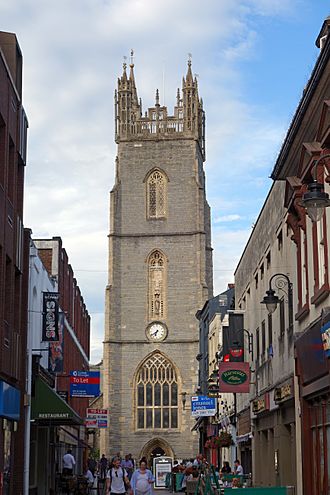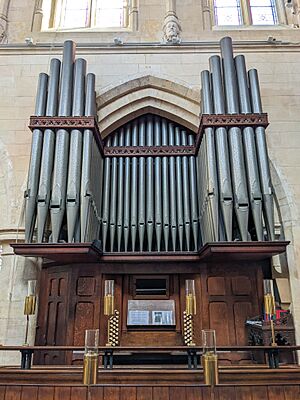St John the Baptist Church, Cardiff facts for kids
Quick facts for kids St John the Baptist Church |
|
|---|---|

View from Church Street
|
|
| General information | |
| Architectural style | Perpendicular Gothic |
| Town or city | Cardiff |
| Country | Wales |
| Coordinates | 51°28′50.59″N 3°10′42.13″W / 51.4807194°N 3.1783694°W |
| Construction started | c. 1460s |
St John the Baptist Church is a very old and important church located right in the middle of Cardiff, Wales. It's so special that it's a Grade I listed building, which means it's protected because of its history and beautiful design. Besides Cardiff Castle, it's the only building from the Middle Ages that still stands in the city centre.
Contents
What St John's Church Looks Like
This church is known for its beautiful and grand appearance. Even in 1851, people described it as an "ancient and finely proportioned edifice." It has a tall, square tower with fancy decorations at the top. These decorations include pierced battlements and four open Gothic pinnacles.
The church's tower is over 40 metres (about 130 feet) tall. It's made of grey limestone with details in a buff-coloured stone called Dundry Stone. This tall tower makes the church easy to spot from different parts of the city centre. You can get great views of it from Church Street, Trinity Street, and Working Street.
The History of St John's Church
Early Beginnings
The church was first built around 1180. Back then, it was a smaller chapel that helped the main St Mary's Church. Monks from Tewkesbury Abbey founded St Mary's. The first church was made from a type of stone called blue Lias, which has layers of fossilised shells. This stone came from a place called Aberthaw. The walls were also decorated with limestone from Dundry.
Rebuilding After a Rebellion
In 1404, during a rebellion led by Owain Glyndŵr, St John's Church was attacked and damaged. It was rebuilt in the second half of the 15th century. During this time, it got its tall, straight tower with ten bells. The tower's top has a crown of openwork battlements, which looks like churches found in the West Country of England. This part of the church was likely finished around 1490.
Becoming the Main Church
In 1607, a big flood in the Bristol Channel damaged the foundations of St Mary's Church. Because of this, St John's and St Mary's worked together as one parish. By 1620, all the main church services were moved to St John's.
In 1843, a wealthy nobleman, the 2nd Marquess of Bute, paid for a new church to replace St Mary's. This new church was called the Church of St Mary and St Stephen. With a new main church built, St John's could be rebuilt and made bigger.
Later Additions and Changes
Between 1886 and 1897, the church was extended using a type of limestone from Culverhouse Cross. The churchyard wall was also rebuilt. It used some of the original blue Lias stone mixed with red sandstone. The top of the wall was finished with stones from the Forest of Dean.
In 1851, the church's seating was replaced by a Cardiff company. The beautiful stained glass windows in the north chapel were added around 1855. These windows show connections to the Bute family. Other stained glass windows, designed by William Morris and his company, were added in 1869.
The church became even wider in 1889 and 1891 when outer aisles were added. The old windows from the original aisles were moved to the new sections. The new parts of the building were covered with Sweldon limestone.
The Churchyard and Gardens
In the 1890s, the church's graveyard was already full. A new public path was created through it, connecting Working Street to Cardiff Central Market. As part of this agreement, the local council, Cardiff Corporation, took care of the southern part of the graveyard. This area later became St John's Gardens. The path itself is still owned by the church and is closed every Good Friday. You can see brass numbers on the path that show where graves and family tombs are located.
In 1952, St John's Church was officially recognised as a Grade I listed building. This means it is considered to be of exceptional architectural and historical importance. The church also serves as the main church in Wales for the Order of Saint John, a charity known for its first aid and ambulance services.
The Church Organ
The organ you see in the church today was built in 1894 by a famous organ builder named "Father" Henry Willis. In 2005, the organ was carefully restored by David Wells of Liverpool. This restoration was paid for by donations and money from the Heritage Lottery Fund. To celebrate the organ's completion, a concert was held with a famous musician named Thomas Trotter. In 2013, the British Institute of Organ Studies gave it a special Grade I Historic Organ Certificate. This shows that it is a very important and interesting organ.
Gallery
-
Altar and reredos done as a memorial to Lord Kitchener














